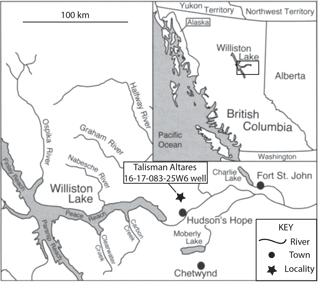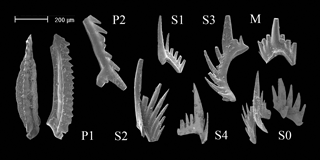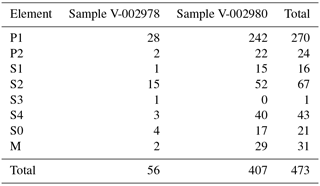Bagnoli, G., Perri, M. C., and Gandin, A.: Ladinian conodont apparatuses from
northwestern Sardinia, Italy, Bolletino della Società Paleontologica
Italiana, 23, 311–323, 1985.
Golding, M. L., Orchard, M. J., Zonneveld, J.-P., Henderson, C. M., and Dunn,
L.: An exceptional record of the sedimentology and biostratigraphy of the
Montney and Doig formations in British Columbia, B. Can. Petrol. Geol., 62, 157–176, 2014.
Goudemand, N., Orchard, M. J., Li, G., Urdy, S., Bucher, H., and Tafforeau,
P.: Synchrotron-aided reconstruction of the conodont feeding apparatus and
implications for the mouth of the first vertebrates, P. Natl. Acad. Sci. USA,
108, 8720–8724, 2011.
Goudemand, N., Orchard, M. J., Tafforeau, P., Urdy, S., Brühwiler, T.,
Brayard, A., Galfetti, T., and Bucher, H.: Early Triassic conodont clusters
from South China: revision of the architecture of the 15 element apparatuses
of the superfamily Gondolelloidea, Palaeontology, 55, 1021–1034, 2012.
Henderson, C. M. and Mei, S.: Geographical clines in Permian and lower
Triassic gondolellids and its role in taxonomy, Palaeoworld, 16, 190–201,
2007.
Henderson, C. M., Wardlaw, B. R., and Lambert, L. L.: Multielement definition of
Clarkina Kozur, Permophiles, 48, 23–24, 2006.
Hirsch, F.: Triassic conodonts as ecological and eustatic sensors, in:
Pangaea: global environments and resources, Embry, A. F., Beauchamp, B., and
Glass, D. J., Memoir of the Canadian Society of Petroleum Geologists,
17, 949–959, 1994.
Huang, J.-Y., Zhang, K.-X., Zhang, Q.-Y., Lü, T., Zhou, C.-Y., Bai,
J.-K., and Hu, S.-X.: Discovery of Middle Triassic conodont clusters from
Luoping Fauna, Yunnan Province, Earth Science, J. China Univ. Geosci.,
35, 512–514, 2010.
Huckriede, R.: Die Conodonten der mediterranen Trias und ihr
stratigraphischer Wert, Paläont. Z., 32, 141–175,
1958.
Ishida, K. and Hirsch, F.: The Triassic conodonts of the NW Malayan Kodiang
Limestone revisited: taxonomy and paleogeographic significance, Gondwana Res.,
19, 22–36, 2011.
Koike, T.: Skeletal apparatuses of Triassic conodonts of Cornudina, in: Professor
Hisayoshi Igo Commemorative Volume, Geology and Paleontology of Japan and
Southeast Asia, edited by: Noda, H. and Sashida, K., Gakujutu Tosho Publisher,
Tokyo, 113–120, 1996.
Koike, T.: Apparatus of a Triassic conodont species Cratognathodus multihamatus (Huckriede),
Paleontol. Res., 3, 234–248, 1999.
Kovács, S.: On the evolution of excelsa-stock in the upper Ladinian-Carnian
(Conodonta, Genus Gondolella, Triassic), New Contributions to the Biostratigraphy of
the Tethyan Triassic, 5, 107–120, 1983.
Kozur, H.: Significance of events in conodont evolution for Permian and
Triassic stratigraphy, Cour. For. Senckenbg., 117, 385–408, 1989.
Kozur, H. and Mostler, H.: Probleme der Conodontenforschung in der Trias,
Geologisch-Paläontologische Mitteilungen Innsbruck, 1, 1–19, 1971.
Kozur, H.: Beitrage zur Conodontenfauna des Perm, Geologsiche
Paläontologische Mitteilungen Innsbruck, 5, 1–41, 1975.
Lindström, M.: A suprageneric taxonomy of the conodonts, Lethaia, 3, 427–445, 1970.
Mietto, P.: A Ladinian conodont-cluster of Metapolygnathus mungoensis (Diebel) from Trento area (NE
Italy), Neues Jahrbuch für Geologie und Paläontologie, Monatshefte,
1982, 600–606, 1982.
Mosher, L. C.: New conodont species as Triassic guide fossils,
J. Paleontol., 44, 737–742, 1970.
Mosher, L. C. and Clark, D. L.: Middle Triassic conodonts from the Prida
Formation of northwestern Nevada, J. Paleontol., 39, 551–565,
1965.
Orchard, M. J.: Multielement conodont apparatuses of Triassic Gondolelloidea,
in: Conodont biology and phylogeny: interpreting the fossil record, edited by:
Purnell, M. A. and Donoghue, P. C. J., Special Papers in Palaeontology,
73, 73–101, 2005.
Orchard, M. J. and Krystyn, L.: Conodonts of the Lowermost Triassic of Spiti,
and new zonation based on Neogondolella successions, Riv. Ital. Paleontol. S.,
104, 341–368, 1998.
Orchard, M. J. and Rieber, H.: Multielement Neogondolella (Conodonta, upper Permian –
middle Triassic), Bolletino della Società Paleontologica Italiana, 37,
475–488, 1999.
Ramovs, A.: Skelettapparat von Pseudofurnishius murcianus (Conodontophorida) im Mitteltrias Sloweniens
(NW Jugoslawien), Neues Jahrbuch für Geologie und Paläontologie,
Abhandlungen, 153, 361–399, 1977.
Ramovs, A.: Mitteltriassiche Conodonten-clusters in Slowenien, NW
Jugoslawien, Paläontol. Z., 52, 129–137, 1978.
Rieber, H.: Ein Conodontencluster aus der Grenzbitumenzone (Mittlere Trias)
des Monte San Giorgio, Annalen des Naturhistorischen Museum in Wien, 83, 265–274, 1980.
Sun, Z., Hao, W., Sun, Y., and Jiang, D.: The conodont genus Nicoraella and a new
species from the Anisian of Guizhou, South China, Neues Jahrb. Geol. P.-A.,
252, 227–235, 2009.
Sweet, W. C.: Uppermost Permian and Lower Triassic conodonts of the Salt
Range and Trans-Indus ranges, West Pakistan, in: Stratigraphic boundary
problems: Permian and Triassic of West Pakistan, edited by: Kummel, B. and Teichert, C.,
The Unviersity Press of Kansas, Lawrence, 207–275, 1970.
Sweet, W. C., in Teichert, C., Kummel, B., and Sweet, W. C.:
Permian-Triassic strata, Kuh-e-Ali Bashi, northwestern Iran, Bulletin of the
Museum of Comparative Zoology, 145, 359–472, 1973.
Tatge, U.: Conodonten aus dem germanischen Muschelkalk, Paläontol.
Z., 30, 108–147, 1956.
Zhang, S. and Yang, Z.: On multielement taxonomy of the Early Triassic
conodonts, Stratigraphy and Paleontology of China, 1, 17–47, 1991.








